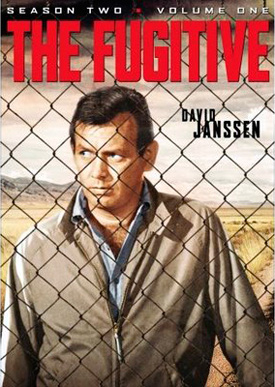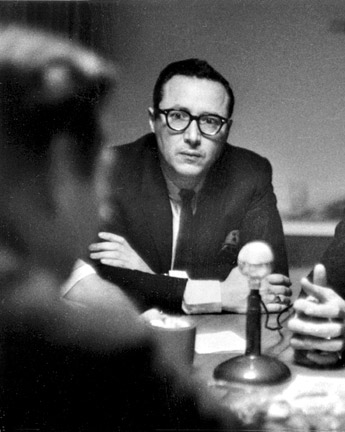

  |
|
|
||||||||||||||||||||||
|
FMS FEATURE... August 15, 2008 The Fugitive Music Debacle: Why It Happened A review, an explanation and some personal thoughts by Jon Burlingame  There had been no advance word of this, only the now-standard disclaimer in tiny lettering on the back of the $40 package: "Some music has been changed for this home entertainment version." Fans were furious. Reviewers jammed the Amazon.com page with phrases like "avoid avoid avoid," "stay away," "defamation of the year," "this is not the Fugitive that I love" and plain old "extremely disappointed." At the popular Home Theater Forum website, "fiasco" and "sickening" were among the more mild expletives among literally hundreds of posts. No one could understand why, especially given the fact that the first season had been successfully released with only the most minor edits. The publicity people at CBS/Paramount Home Video were flummoxed. No one had alerted them to the potential firestorm. After days of pressure from Daily Variety for an explanation, CBS Home Entertainment released this statement: "Obviously we would have preferred to include all the original music in The Fugitive second season DVD release, but unlike season one, there were a large number of cues, the current ownership of which was not clear. We didn't want to disappoint fans by significantly delaying the release of the second season, so we chose to replace the music. "We kept the original theme song, but decided it would be better to rescore full episodes to give viewers a seamless, consistent experience throughout. Taking everything into consideration, we thought this was the best solution." The studio refused to answer any specific questions about the music mess. When I wrote the Variety story, published June 23, I managed to reach a high-ranking studio executive with first-hand knowledge of the problem. And while he wouldn't go on the record with me, he did offer a few cryptic lines that didn't really make sense to me at the time. Now they do. In order to understand what the problems were, and why CBS/Paramount took the bizarre course it did, a few words of explanation are in order about exactly how The Fugitive was scored. All four years of the Quinn Martin series (1963-1967) utilized pre-existing music. Pete Rugolo, the architect of the Stan Kenton sound of the 1950s and composer of such TV classics as Richard Diamond and Thriller, wrote the theme and a library of original cues which were designed for "tracking" throughout the series – that is, applied wherever dramatically effective, even though not written for any specific scene. This was recorded in London under the supervision of John Elizalde, post-production supervisor on the series.  Composer Pete Rugolo But the Rugolo library (estimated by Elizalde, in an interview done for my book TV's Biggest Hits, at 75-90 minutes of music) would not be sufficient to score every episode. In 1963, tracking of pre-existing music – often libraries of generic dramatic music, sometimes written for B movies, sometimes for earlier TV shows, sometimes simply mood music of the era – was still permitted under union rules (although it was frowned upon and would soon be discontinued as a widespread practice). So Elizalde and music editor Ken Wilhoit took advantage of the CBS Music Library, which was a goldmine of music written for such shows as Gunsmoke, The Twilight Zone, Have Gun - Will Travel, Rawhide, Perry Mason and The Lineup by such stellar talents as Jerry Goldsmith, Bernard Herrmann, Fred Steiner and others. And, as time went on, they also made use of the Capitol Music Library and eventually music written by Dominic Frontiere for various early 1960s shows. Still, nearly all of the music for The Fugitive, especially in its first two years, came either from Rugolo's Fugitive-specific library or the then-licensed CBS Library. So why did CBS/Paramount replace all of the dramatic underscore for its second-season Fugitive package, especially since nearly all of the music is the same and it is all controlled (for Fugitive DVD purposes) by the CBS-Viacom empire? The key lies in the cue sheets, those studio documents that list every piece of music in every episode, along with the names of the composer, publisher, duration and specifics about its use. They are prepared at the time the show goes on the air and are filed with ASCAP and BMI, the performing-rights societies that distribute music royalties to composers and publishers. The cue sheets for The Fugitive, as it turns out, are unorthodox. Instead of the usual cue-by-cue recitation of each piece of music used, the Fugitive cue sheets are organized by publisher, and the listed cues do not appear in chronological order. For example, on the second-season episode "Escape Into Black," the cue sheet cites 19 uses of Rugolo music – as little as six seconds ("Fugitive Curtain No. 1") to as long as 63 seconds ("Fugitive Suspense") – and 42 instances of CBS Library music (including three by Herrmann, 13 by Goldsmith, 11 by Steiner and others by CBS stalwarts Rene Guerriguenc and Nathan Scott, among others). And a single instance of Capitol Library music (39 seconds, by Nick Carras). Total music in that episode: just over 35 minutes, according to the cue sheet. Couple this with the fact that ownership of the music in the Capitol library is now in dispute, according to sources inside CBS/Paramount and within the music community outside. With different parties claiming ownership, there is no easy way (perhaps no way at all) to legally clear music from the Capitol library. The high-ranking executive indicated that "all that is in question are the Capitol cues," but that "there was no way, from the cue sheets, that [the music department] could figure out which was Capitol and which was ours. It wasn't CBS being cheap. We were told legally that we didn't know what was what, and we had to change it." This seemed strange to me at the time. Now that I've seen the cue sheets, I understand their problem. Unless one knows those shows – and more specifically that music – extremely well, a novice would have a hard time separating the Rugolo from the Goldsmith from the Steiner from the generically Capitol. So CBS/Paramount took the extreme measure of stripping it all out and replacing it with a new library written by Mark Heyes (Grace Under Fire) with additional contributions by Sam Winans (Lizzie McGuire) and Ron Komie (The Amazing Race). Music editor Roy Braverman, who had "no comment" to queries about the new music, at one time wrote on his website that the new music was "in the style of" the 1960s scores. That is a matter of opinion. Heyes declined interview requests. What happened between the DVD releases of season 1 and season 2 – two seasons, scored in exactly the same way – to force this issue? Did someone inside CBS/Paramount suggest an internal review and make a late-in-the-game discovery that the music situation was more complicated than anyone guessed? No one is talking now, so we may never know. Also unanswered are questions about what it cost CBS/Par to locate the original video and audio elements in order to strip out the original music; to hire new composers to create generic dramatic music that would seem appropriate for a 44-year-old series; and digitally alter the end credits in every episode to reflect their contributions. Some estimates suggest it may have cost as much as $100,000. But here's the rub: No matter how complicated this may have seemed to the executives at CBS/Paramount, the action they took – ruining one of the all-time classic TV dramas – was unnecessary. There are experts in Los Angeles who are intimately familiar with this music, among them music editor Ken Wilhoit, who performed all that detective work in the first place. And he's not the only one. These people can instantly spot a Herrmann cue versus a Goldsmith cue, and could, with a few weeks and a little effort, correctly identify every piece of music in the second season of The Fugitive. And those very few Capitol cues in dispute could easily be removed and replaced by generic music, salvaging the vast majority of original score for fans to enjoy. Having made this terrible decision about the first half of season 2 – and having spent a great deal of money to unearth the original elements and pay for new music that was never necessary in the first place – it seems unlikely that we can expect that the second half of season 2 (assuming sales of the first half justify any further releases) will sound any different than the first. So hang onto your VHS tapes of The Fugitive. It's the only way you'll be able to hear the series the way it was meant to be. ©2008 Jon Burlingame |
Search
Past Features
|